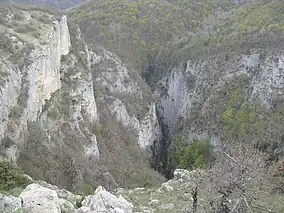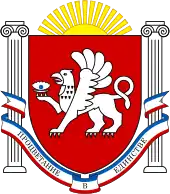Grand Canyon (Crimea)
The Grand Canyon of Crimea (Ukrainian: Великий каньйон Криму, romanized: Velykyi kanion Krymu; Russian: Большой каньон Крыма, romanized: Bolshoy kanon Kryma) is a canyon located in southern Crimea, an area internationally recognised as part of Ukraine but currently controlled by Russia. The Grand Canyon separates the Ai-Petri and Boyka massifs, and the area of the Grand Canyon zakaznik (nature reserve) is 500 ha (5.0 km2). It has a depth of 320 m (1,050 ft), and its bottom are several springs.
| Grand Canyon of Crimea | |
|---|---|
| Великий каньйон Криму (Ukrainian) Большой каньон Крыма (Russian) | |
IUCN category VI (protected area with sustainable use of natural resources) | |
 | |
.jpg.webp) Location of the Grand Canyon within Crimea  Grand Canyon (Crimea) (Ukraine) | |
| Location | Crimean Mountains, Crimea |
| Nearest city | Bakhchysarai |
| Coordinates | 44°31′40″N 34°01′00″E |
| Area | 500 ha (5.0 km2) |
| Established | 1974 |
Description
The Grand Canyon of Crimea was formed around 2 million years ago by a tectonic crack.[1] It is approximately 3 km (1.9 mi) long, and its walls, made of limestone, reach 320 m (1,050 ft) high.[2] At the bottom of the canyon, widths reach as thin as 2 m (6.6 ft).[3] The canyon is located between the Ai-Petri and Boyka massifs.[1] The walls of the canyon are home to a variety of different types of trees and herbs, but are prone to rock slides during dry weather and after rain.[3] On the Boyka side of the canyon is the Cathedral of Christ the Saviour, a ruined church Eastern Orthodox icons are placed.[4]
At the bottom of the canyon are a variety of bodies of water, including several springs, for which it is best known. Among its rivers are the Avuzıñ Özen and the Kökköz.[1] The former river itself produces several springs, among them the Pania, Crimea's largest karstic spring.[3] During the dry season, one can venture on from the Avuzıñ Özen to the Cow's Grotto.[1] There are also forests at the Canyon's bottom, inhabited by hedgehogs, badgers, and roes.[3] The canyon's bottom is typically cool, owing to the coverage of yew, oak, and beech forests located on the slopes. One can find rare species of Cypripedium in the canyon.[5]
The first person to describe in detail the features of the Grand Canyon of Crimea was Russo-Ukrainian scientist Ivan Puzanov, who explored the canyon in 1925. Puzanov also gave the canyon its name.[1]
Legends
The Grand Canyon of Crimea is home to several local legends. Prior to his 1925 description of the canyon, Puzanov recorded a local legend from a groundskeeper at Yusupov Palace, who stated, "Our peasants say that at night, wild cries and squeals are heard, and laughter - demons celebrate their weddings then." This legend possibly emerged due to the loud and destructive flooding in the canyon in the aftermath of rain and during the spring,[6] when the Avuzıñ Özen rises by 5 metres.[5]
The Postal Oak, located near the Cow's Grotto, is another legendary location. It is a destroyed tree which is said to grant the wishes of those who deposit notes into it.[4]
The most significant landmark in the canyon, however, is the Fountain of Youth, or Kara-Gol (Ukrainian: Кара-Голь). The Fountain of Youth, a 5-metre erosion in the Avuzıñ Özen,[5] is thought by local legend to possess rejuvenating powers, and never surpasses 10-13°C (50-55°F).[3]
References
- Smagin, Alexander. "Grand Canyon of Crimea". Russian Information Center. Retrieved 5 February 2023.
- Yena, O. V. "Великий каньйон Криму" [Grand Canyon of Crimea]. Encyclopedia of Modern Ukraine (in Ukrainian). Retrieved 5 February 2023.
- "The Grand Canyon". Discover Ukraine. Retrieved 5 February 2023.
- "Загадки Большого каньона Крыма. НЛО и другие необъяснимые явления" [Mysteries of the Grand Canyon of Crimea: UFOs and other unexplained phenomena]. Yandex Zen (in Russian). 18 December 2019. Retrieved 5 February 2023.
- "Великий каньйон Криму" [Grand Canyon of Crimea]. I love Ukraine - Interesting Places (in Ukrainian). 29 January 2017. Retrieved 5 February 2023.
- "Ванна молодости" [Fountain of Youth]. Tavridaru.ru (in Russian). Retrieved 5 February 2023.

